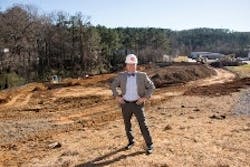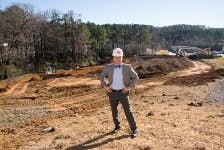It was a sultry but otherwise unremarkable day in May 2016 when I received the call. The owners of a property adjacent to our campus asked to meet with me, as they wanted to sell their property. I was happy to take the meeting. Over the next several days, we exchanged ideas about terms and then agreed to proceed with the transaction. The timing of this was perfect. We had outgrown our parking capacity through the years and needed more space.
Plus, all employee, supplier, and commercial traffic shared the same entrance to the campus. A second road was needed to alleviate congestion. And even though the two projects were on opposite sides of the campus, the additional property was the linchpin to making all of this possible.
The project would also support our strong practice of promoting wellness: The property sections could be tied together with a nature/walking trail, which could potentially connect both ends of the campus. By my estimation, we would be able to close on the sale in 45 days and begin planning the parking lots and road immediately. Weather permitting, we could have this wrapped up by the end of the year…easy breezy.
Or so I thought. We made it through a few unforeseen delays, and the Alabama summer had begun to recede into fall when I got a call that the property had been cleared and they were ready for closing. I hung up the phone, happy that this would be coming to an end, when it hit me: I wonder how the property is zoned…? For our purposes, it needed to be commercial. A quick call to the city confirmed my fear: It was zoned residential. I don’t know why I didn’t think of this sooner; it was a rookie error on my part. I should have done this due diligence months ago, but it slipped my mind.
December (2016) and January saw me meeting with the city, writing letters to adjoining properties, and representing our interest in front of the zoning board of appeals and the city council. By spring, all of the necessary documents had been drafted and we were set to close, approximately one year after our first meeting.
After the closing, I climbed the hill again to see what we had purchased. Now cleared, the property looked pretty good. As I began my descent down the hill, my toe caught something metal. I looked down to see a horseshoe – rusty, but intact. A good omen? A change in luck? Perhaps. I took it back to my office, where it has remained.
The planning for the parking lots and truck lane took the cadence that most projects like this take, with one exception. I learned in a meeting with our contractor and engineers that the timeline would be informed by weather (which I understood) and by the Indiana Gray Bat. I laughed when this was announced, assuming it was an inside joke that they would share. I was the only one laughing.
I pressed for an explanation and learned that like me, the Indiana Gray Bat has chosen to work and live in Alabama. Important to the environment, these bats nest in large quantities. In fact, as many as 500 bats will roost in one square foot, with the largest caves supporting 20,000 to 50,000 at a time. It’s easy to understand how disrupting their habitat can have grave consequences. It appeared that our intended start date coincided with their mating and subsequent parenting season, which is done above ground. (Naturally, they’d like some privacy.) We’d just have to wait and see if there was any indication that the area to be deforested was indeed host to these bats.
About a month later, we learned that all waterways were safe and that we saw no current or past evidence of the imperiled Indiana Gray Bat. We were good to go.
Deforesting began in August, and dirt began shifting in early September. As of this writing, the parking lots are ready for curbs, the roadway is taking shape, and the final layout for the walking trail is being fine-tuned. Next, we’ll replant some trees and replace some fencing. All of this should be completed in May, approximately two years after that first meeting.
I was lamenting this series of events to a friend, and he began extolling the virtues of patience. I won’t share what I extolled back. But he was right. When embarking on a project of this magnitude, it takes a good deal of patience as well as a good sense of humor. In the end, it turned out that I needed to develop more patience, sooner. Stay tuned.

